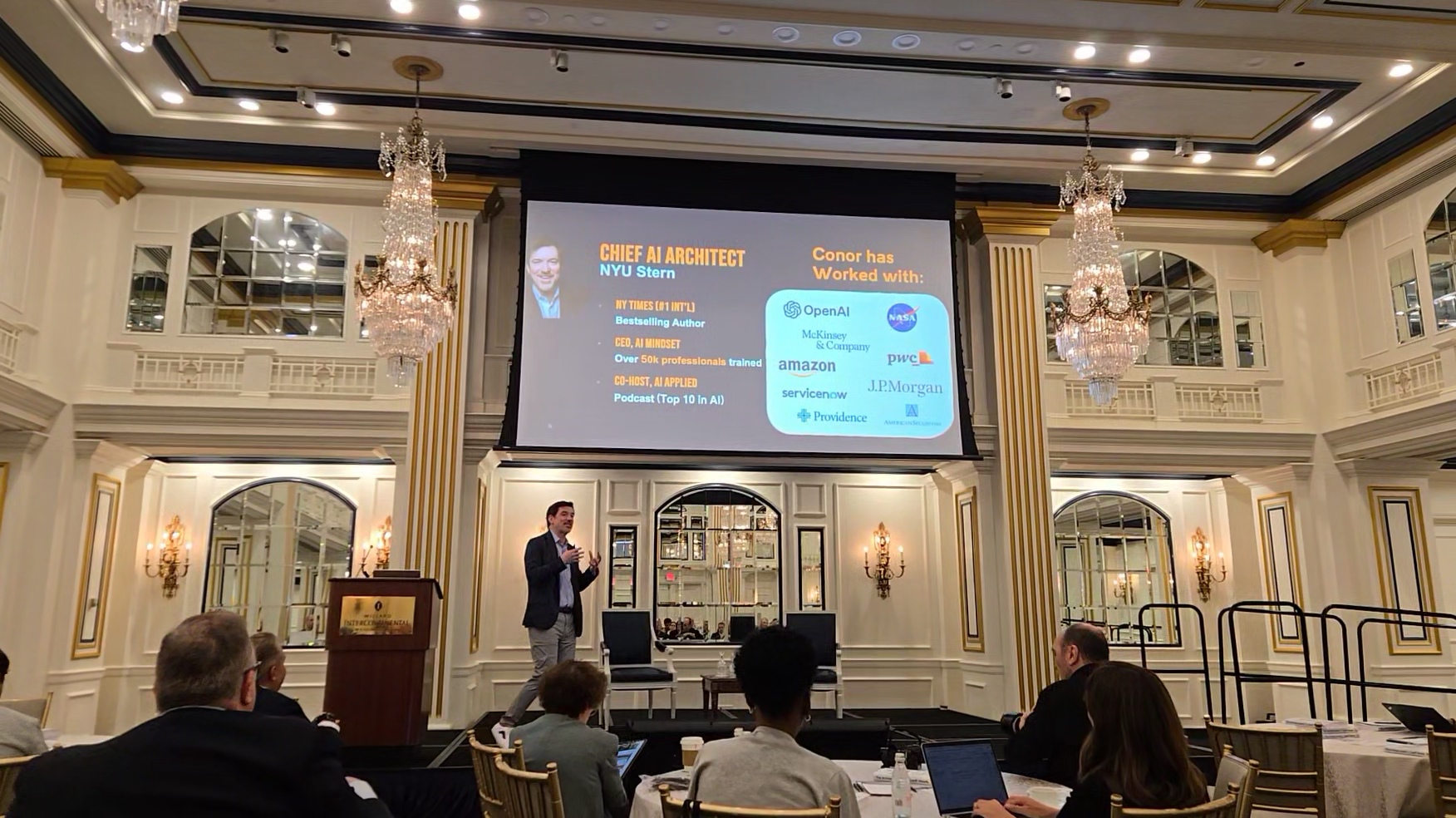What does AI Advantage mean?
At the Fisher Phillips AI Advantage Conference for Business Leaders, Chief AI Architect at NYU Conor Grennan delivered the keynote titled "Generative AI: Practical Strategies to Increase Productivity". The talk focused not just on AI technology itself, but on the behavioral and organizational shifts required to make AI effective.
The central theme was that generative AI is not just another software tool and it certainly is not just a better Google; it represents a transformative shift in how individuals and organizations work. Grennan emphasized that AI adoption is not about learning new tools but about changing daily behavior. Early discussions about AI focused on anxiety and disruption (“AI stress”), but today the conversation has moved towards “AI advantage”: how do firms unlock real productivity gains by building AI into how they operate?
To illustrate what meaningful AI adoption looks like in practice, Grennan introduced a series of behavioral paradigms. These simple yet powerful mental models for approaching generative AI in daily work reflect real-world barriers and mindset shifts that determine whether AI becomes a habit or remains an unused tool. Here are some of Conor's Paradigms:
The Costa Rica Paradigm
One of the metaphors that really stuck with me was the "Costa Rica Paradigm." If you imagine you are going on a vacation to Costa Rica, you wouldn't just ask: "What are the top 10 things to do?" Instead, you’d want to talk to someone who really knows the place. You’d share that you like hiking, beaches, or hidden local spots, and ask for suggestions. You’d go back and forth until you reach the desired result.
Grennan explained how most people instinctively treat AI like a search engine: type a command, get a response, and move on. But that mindset limits the tool's value. Instead, we should treat AI like a conversation with the Head of the Costa Rican tourism board: share preferences, ask follow-ups, and refine the answer through dialogue. Indeed you can tell your AI agent that it is the head of tourism and answer accordingly!
“We keep treating generative AI like any other software, but it behaves like a person.”
The Treadmill Paradigm
Grennan used what he called the "treadmill paradigm" to capture one of the most common misconceptions about AI adoption. Simply having access to powerful generative AI tools won’t instantly improve productivity, just like owning a fancy treadmill won’t instantly make you fit.
Building AI into your routine isn’t a training challenge, it’s a behavior challenge. Most professionals already have AI tools at their fingertips, but without building them into a daily routine, those tools sit unused. Like fitness, meaningful adoption comes through habit, consistency, and repetition– not a single training session or product rollout. Much like putting a treadmill in the homes of every American will not sort out heart disease, dropping an AI tool onto your all of your employees computers and phones will not give you the AI advantage. You need to ensure it is used.
“AI adoption is not a learning curve—it’s a behavioral curve.”
The Invisible Paradigm
Grennan also addressed what he called "The Invisible Paradigm": the challenge that many users face when confronted with the open-endedness of generative AI. This total freedom sounds great, but in practice, it is overwhelming. Users often freeze at the blank input field, not because they lack ideas, but because they lack patterns of behavior.
Grennan compared it to being told to write an essay on any topic in the world. That kind of total freedom seems like it should be easier, but in reality, it makes getting started harder. On the other hand, when you're given a specific prompt, the constraints help you focus and generate ideas. Generative AI is the same way: we need prompts, patterns, and constraints to unlock our thinking. There’s no obvious starting point, and the lack of structure makes the tool feel opaque. Without clear patterns, reusable templates, and scaffolding to help users confidently integrate AI into their thinking and work, the most powerful tools remain invisible to the people who need them most.
“Don’t overthink the prompt. Start with your problem.”
Leadership & Culture Are the Real Accelerators
Ultimately, Grennan emphasized that the most powerful predictor of AI adoption is whether leaders use it themselves. Leaders set the tone by removing the stigma around AI usage and providing guardrails for ethical, thoughtful use.
Grennan ended by reminding the audience that AI is not replacing judgment—it’s augmenting it. The future of productivity won't be AI versus humans; it will be humans who use AI well versus those who don’t. “The best predictor of AI adoption in any company is whether the leadership team uses it personally and publicly.”
Ultimately, Grennan emphasized that the most powerful predictor of AI adoption is whether leaders use it themselves. When senior leaders use AI visibly and consistently, they are signalling to their teams that experimentation is not only allowed—it’s encouraged. This kind of modeling helps normalize AI use as part of everyday problem-solving rather than something done quietly or in isolation. Without visible leadership, AI risks becoming a hidden tool that individuals use on the side but hesitate to admit, unsure if it’s really “allowed.” That creates a culture of uncertainty and missed opportunity. When leaders talk openly about how they’re using AI (what works, what doesn’t, and where they’re experimenting), it creates space for honest dialogue, shared learning, and collective progress.






/Passle/53d0c8edb00e7e0540c9b34b/MediaLibrary/Images/2025-06-24-15-50-59-531-685ac963d81bf11b7522dd8e.png)
/Passle/53d0c8edb00e7e0540c9b34b/MediaLibrary/Images/2025-12-18-10-52-26-493-6943dceac311190ddba15d64.jpg)
/Passle/53d0c8edb00e7e0540c9b34b/MediaLibrary/Images/2025-12-16-15-16-25-843-694177c9190f803408651724.jpg)
/Passle/53d0c8edb00e7e0540c9b34b/MediaLibrary/Images/2025-12-09-11-05-31-284-6938027b1b6076d9d8980f1e.png)
/Passle/53d0c8edb00e7e0540c9b34b/MediaLibrary/Images/2025-12-04-20-27-35-105-6931eeb7f170698845c6b19b.jpg)



